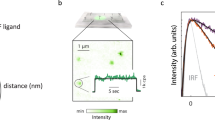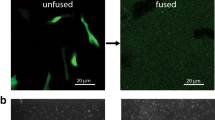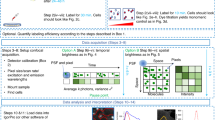Abstract
We present a method for monitoring receptor dimerization at the membrane of live cells. Chimeric proteins containing the epidermal growth factor (EGF) receptor extracellular and transmembrane domains fused to weakly complementing β-galactosidase (β-gal) deletion mutants were expressed in cells in culture. Treatment of the cells with EGF-like compounds for as little as 15 s resulted in chimeric receptor dimerization detectable as β-gal enzymatic activity. The dose response of chimeric receptors was ligand specific. β-galactosidase complementation was reversible upon removal of ligand and could be reinduced. Antibodies that block ligand binding inhibited receptor dimerization and β-gal complementation. These results demonstrate that β-gal complementation provides a rapid, simple, and sensitive assay for protein interactions and for detecting and monitoring the kinetics of receptor dimerization.
This is a preview of subscription content, access via your institution
Access options
Subscribe to this journal
Receive 12 print issues and online access
$209.00 per year
only $17.42 per issue
Buy this article
- Purchase on Springer Link
- Instant access to full article PDF
Prices may be subject to local taxes which are calculated during checkout




Similar content being viewed by others
References
Schlessinger, J. & Ullrich, A. Growth factor signaling by receptor tyrosine kinases. Neuron 9, 383–391 (1992).
Ullrich, A. & Schlessinger, J. Signal transduction by receptors with tyrosine kinase activity. Cell 61, 203–212 (1990).
Weiss, F.U., Daub, H. & Ullrich, A. Novel mechanisms of RTK signal generation. Curr. Opin. Genet. Dev. 7, 80–86 (1997).
Fields, S. & Song, O. A novel genetic system to detect protein-protein interactions. Nature 340, 245–246 (1989).
Miyawaki, A. et al. Fluorescent indicators for Ca2+ based on green fluorescent proteins and calmodulin. Nature 388, 882–887 (1997).
Rossi, F., Charlton, C.A. & Blau, H.M. Monitoring protein–protein interactions in intact eukaryotic cells by β-galactosidase complementation. Proc. Natl. Acad. Sci. USA 94, 8405–8410 (1997).
Pelletier, J.N., Campbell-Valois, F.X. & Michnick, S.W. Oligomerization domain-directed reassembly of active dihydrofolate reductase from rationally designed fragments. Proc. Natl. Acad. Sci. USA 95, 12141–12146 (1998).
Ullmann, A., Perrin, D., Jacob, F. & Monod, J. Identification par complémentation in vitro et purification d'un segment de la β-galactosidase d'Escherichia coli. J. Mol. Biol. 12, 918–923 (1965).
Mohler, W.A. & Blau, H.M. Gene expression and cell fusion analyzed by lacZ complementation in mammalian cells. Proc. Natl. Acad. Sci. USA 93, 12423–12427 (1996).
Rossi, F.M.V., Blakely, B.T., Charlton, C.A. & Blau, H.M. in Chimeric proteins (eds Emr, S.D. & Thorner, J.) in press (Academic Press, San Diego, CA; 2000).
Rossi, F.M.V., Blakely, B.T. & Blau, H.M. Interaction blues: protein interactions monitored live in mammalian cells by β-galactosidase complementation. Trends Cell Biol. 10, 119–122 (2000).
Livneh, E. et al. Reconstitution of human epidermal growth factor receptors and its deletion mutants in cultured hamster cells. J. Biol. Chem. 261, 12490–12497 (1986).
Gadella, T.W., Jr. & Jovin, T.M. Oligomerization of epidermal growth factor receptors on A431 cells studied by time-resolved fluorescence imaging microscopy. A stereochemical model for tyrosine kinase receptor activation. J. Cell Biol. 129, 1543–1558 (1995).
Nagata, S. Apoptosis by death factor. Cell 88, 355–365 (1997).
Haigler, H., Ash, J.F., Singer, S.J. & Cohen, S. Visualization by fluorescence of the binding and internalization of epidermal growth factor in human carcinoma cells A-431. Proc. Natl. Acad. Sci. USA 75, 3317–3321 (1978).
Stoscheck, C.M. & Carpenter, G. Characterization of the metabolic turnover of epidermal growth factor receptor protein in A-431 cells. J. Cell Physiol. 120, 296–302 (1984).
Cowley, G.P., Smith, J.A. & Gusterson, B.A. Increased EGF receptors on human squamous carcinoma cell lines. Br. J. Cancer 53, 223–229 (1986).
Felder, S., LaVin, J., Ullrich, A. & Schlessinger, J. Kinetics of binding, endocytosis, and recycling of EGF receptor mutants. J. Cell Biol. 117, 203–212 (1992).
Kiyokawa, N., Lee, E.K., Karunagaran, D., Lin, S.Y. & Hung, M.C. Mitosis-specific negative regulation of epidermal growth factor receptor, triggered by a decrease in ligand binding and dimerization, can be overcome by overexpression of receptor. J. Biol. Chem. 272, 18656–18665 (1997).
Beerli, R.R. & Hynes, N.E. Epidermal growth factor-related peptides activate distinct subsets of ErbB receptors and differ in their biological activities. J. Biol. Chem. 271, 6071–6076 (1996).
Gill, G.N. et al. Monoclonal anti-epidermal growth factor receptor antibodies which are inhibitors of epidermal growth factor binding and antagonists of epidermal growth factor binding and antagonists of epidermal growth factor-stimulated tyrosine protein kinase activity. J. Biol. Chem. 259, 7755–7760 (1984).
Winkler, M.E., O'Connor, L., Winget, M. & Fendly, B. Epidermal growth factor and transforming growth factor alpha bind differently to the epidermal growth factor receptor. Biochemistry 28, 6373–6378 (1989).
Carraway, K.L. & Cerione, R.A. Inhibition of epidermal growth factor receptor aggregation by an antibody directed against the epidermal growth factor receptor extracellular domain. J. Biol. Chem. 268, 23860–23867 (1993).
Yarden, Y. & Schlessinger, J. Epidermal growth factor induces rapid, reversible aggregation of the purified epidermal growth factor receptor. Biochemistry 26, 1443–1451 (1987).
Cochet, C. et al. Demonstration of epidermal growth factor-induced receptor dimerization in living cells using a chemical covalent cross-linking agent. J. Biol. Chem. 263, 3290–3295 (1988).
Pollok, B.A. & Heim, R. Using GFP in FRET-based applications. Trends Cell Biol. 9, 57–60 (1999).
Remy, I., Wilson, I.A. & Michnick, S.W. Erythropoietin receptor activation by a ligand-induced conformation change. Science 283, 990–993 (1999).
Zabin, I. β-Galactosidase α-complementation. A model of protein–protein interaction. Mol. Cell. Biochem. 49, 87–96 (1982).
Langley, K.E. & Zabin, I. β-Galactosidase α complementation: properties of the complemented enzyme and mechanism of the complementation reaction. Biochemistry 15, 4866–4875 (1976).
Pegram, M. et al. Inhibitory effects of combinations of HER-2/neu antibody and chemotherapeutic agents used for treatment of human breast cancers. Oncogene 18, 2241–2251 (1999).
Fiering, S.N. et al. Improved FACS-Gal: flow cytometric analysis and sorting of viable eukaryotic cells expressing reporter gene constructs. Cytometry 12, 291–301 (1991).
Nolan, G.P., Fiering, S., Nicolas, J.F. & Herzenberg, L.A. Fluorescence-activated cell analysis and sorting of viable mammalian cells based on β-D-galactosidase activity after transduction of Escherichia coli lacZ. Proc. Natl. Acad. Sci. USA 85, 2603–2607 (1988).
Alberti, S., Parks, D.R. & Herzenberg, L.A. A single laser method for subtraction of cell autofluorescence in flow cytometry. Cytometry 8, 114–119 (1987).
Acknowledgements
We thank Xiao-Jia Chang, Carol Zuschlag, Carol Charlton, Joyce Tung (funded by Howard Hughes Medical Institute undergraduate research fellowship), and Patricia Wong (funded by the Stanford Medical School Alumni Scholarship) for technical assistance. F.M.V.R. was funded by a fellowship from the Human Frontier Science Program. This research was supported by National Institute of Health grants to H.M.B.
Author information
Authors and Affiliations
Corresponding author
Rights and permissions
About this article
Cite this article
Blakely, B., Rossi, F., Tillotson, B. et al. Epidermal growth factor receptor dimerization monitored in live cells. Nat Biotechnol 18, 218–222 (2000). https://doi.org/10.1038/72686
Received:
Accepted:
Issue Date:
DOI: https://doi.org/10.1038/72686
This article is cited by
-
Testing cancer inhibitors at scale
Nature Biomedical Engineering (2018)
-
Interaction of galectin-3 with MUC1 on cell surface promotes EGFR dimerization and activation in human epithelial cancer cells
Cell Death & Differentiation (2017)
-
Molecular Imaging of Phosphorylation Events for Drug Development
Molecular Imaging and Biology (2009)
-
Targeted Cell Entry of Lentiviral Vectors
Molecular Therapy (2008)
-
A Split Enhanced Green Fluorescent Protein-Based Reporter in Yeast Two-Hybrid System
The Protein Journal (2007)



